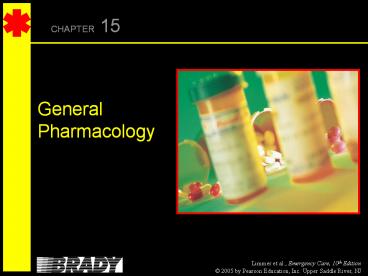General Pharmacology - PowerPoint PPT Presentation
1 / 30
Title:
General Pharmacology
Description:
... Suspensions Fine Powder for Inhalation Gases Sublingual Spray Metered-Dose Inhaler Indication Specific sign, symptom, or circumstance that makes it appropriate to ... – PowerPoint PPT presentation
Number of Views:193
Avg rating:3.0/5.0
Title: General Pharmacology
1
CHAPTER 15
General Pharmacology
2
Key Term
Pharmacology
The study of drugs, their sources,
characteristics, and effects
3
Overview ofMedications Used bythe EMTB
4
Medications Carried on the EMS Unit
- Activated charcoal
- Oral glucose
- Oxygen
5
Medications Prescribed to Patients
- Prescribed inhaler
- Nitroglycerin
- Epinephrine
6
What the EMTBNeeds to KnowAbout Medications
7
Medication Names
- All listed in U.S. Pharmacopoeia
- Generic name
- Chemical name
- Trade name
8
3 Types of Medication Names
- Generic name epinephrine
- Chemical name B- (e, 4 dihydroxyphenyl)
amethylaminoethanol - Trade name Epi-Pen
9
Forms ofMedications
10
Compressed Powders or Tablets
11
Liquids for Injection
12
Gels
13
Suspensions
14
Fine Powderfor Inhalation
15
Gases
16
Sublingual Spray
17
Metered-Dose Inhaler
18
Indication Specific sign, symptom, or
circumstance that makes it appropriate to
administer a drug
19
Contraindication Specific sign, symptom, or
circumstance in which it would be inappropriate,
or harmful, to administer a drug
20
Dose How much should be given to a
patient Actions Desired effects on a
patient Route How the medication is administered
(i.e., orally, sublingually, by injection)
21
Side Effects
Any action of the drug other than the desired
actions Some side effects are predictable (e.g.,
headache as a side effect of nitroglycerin).
22
Proper Use ofMedications in the Field
23
Medication Administration
- Right patient?
- Right medication?
- Right dose?
- Right route?
Four Rights
24
Medication Administration
- Patients must be reassessed after medication is
administered. - Repeat vital signs.
- Document patients response to medication.
25
Review Questions
1. Define the following terms
- Generic name
- Trade name
- Indication
- Contraindication
- Dose
- Action
- Side effect
26
Review Questions
- 2. List the forms of medications.
- 3. List the four rights in medication
administration. - 4. Why must patients be reassessed after
medication has been given?
27
STREET SCENES
- What additional patient history should you
obtain? - Should you let the patient take nitroglycerin?
Why or why not?
28
STREET SCENES
- Are vital signs important if nitroglycerin is
going to be taken by the patient? - What information do you want to know about
nitroglycerin?
29
STREET SCENES
- How should the nitroglycerin be administered?
- When should vital signs be taken again?
30
Sample Documentation































